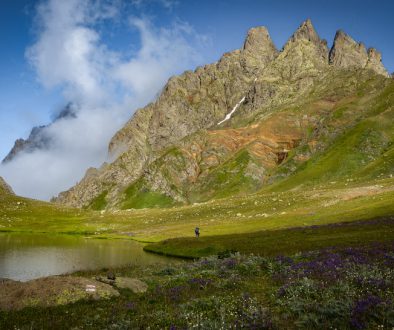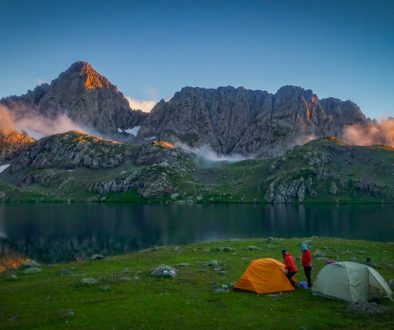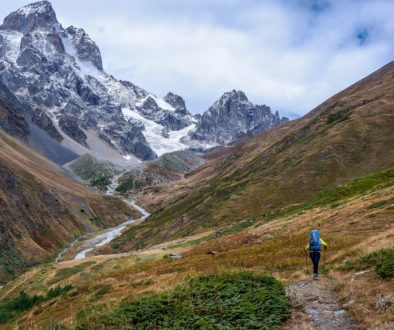Thru-Hike Armenia: New 2023 Route & Resources
The border-to-border thru-hike on the Transcaucasian Trail across Armenia has just received its first big annual update! Check out the route resources here.
In this post, we’ll give you a run-down of the changes to the route and some insights into why they’ve been made. But first, let’s have a look at the key facts and figures for the new Armenia thru-hike for 2023, including comparisons with 2022 (in brackets):
Updated 2023 Transcaucasian Trail Armenia Route: Facts & Figures
- Distance between termini: 861.3km / 535.2mi (+4%)
- Number of stages: 106 (=)
- Average stage length: 8.1km / 5mi (+4%)
- Proportion on traffic-free footpaths: 29% (+8.5%)
- Proportion on 4×4 tracks: 44.8% (-5.4%)
- Proportion on other track types: 25.9% (-0.9%)
- Proportion waymarked/signed: 35.2% (+2.6%)
- Total ascent (southbound): 28,837m / 94,610ft (+9%)
- Total descent (southbound): 30,187m / 99,039ft (+8.6%)
- Max elevation: 3,467m / 11,375ft
- Min elevation: 682m / 2,239ft

What’s New For The 2023 Armenia Thru-Hike?
The first thing you’ll notice from the figures about is that the total distance for 2023 is 31.3km longer. That’s a full extra day’s hiking at thru-hiking pace. We hope you’ll see that as we do: a bonus day on the trail in one of the best up-and-coming hiking destinations on the planet!
Most of the extra steps you’ll be taking can be explained by a single big change – specifically, the brand new route through the Debed Canyon in Lori province.
For many of last season’s thru-hikers, this epic gorge of columnar basalt and whitewater rapids passed them by in a few short hours, because of the route’s relatively rapid crossing of the gorge. And because of its position within the thru-hike, many northbound hikers felt that it was part of the final push for the northern terminus. These kinds of reports suggested the route wasn’t quite doing justice to one of the most breathtaking hiking regions in Armenia.
That’s changing for 2023, thanks in part to a major effort by our friends at Trails for Change and Children of Armenia Fund to open up more than 100km of brand new trails in the Debed Canyon – a network we played a central role in designing. As a result, there’s now a wealth of new options to choose from for a more thorough exploration of the canyon and its sights.

After several experimental hikes this year with members of our supporters’ treks, the route we’ve chosen focuses on a new resupply stop in Alaverdi, the principal city in northern Lori. While much of the canyon is devoid of services, in Alaverdi you’ll find supermarkets, ATMs, pharmacies and plenty of other amenities. (The approach to Alaverdi also passes right by one of our favourite guesthouses, Iris B&B, where you’re highly advised to stop for the night and treat yourself to one our good friend Irina’s lavish feasts.)
Designing new approaches to Alaverdi has also allowed us to work some of the region’s most unique and wonderful historic trails into the route – a big part of the rationale for adding an extra day of hiking.
Newly incorporated highlights include the well-known but truly incredible stone staircase between Kobayr Monastery with its shared Georgian-Armenian heritage, and the ancient settlement of Odzun with its 4th-century church, one of the oldest in the country.

Heading southbound out of Alaverdi, you’ll climb a newly reopened series of rock-hewn switchbacks up through the basalt cliffs above the canyon, taking you from the 10th-century Sanahin Bridge across the River Debed to the UNESCO World Heritage site of Sanahin Monastery.
In the rolling backcountry between Lori and Tavush, we’ve finally been able to include a tough but frankly mind-blowing panoramic ridge hike that climbs alongside the eastern rim of the Debed Canyon and passes beneath Mt Dzharsar (2,256m), aka: Chatin Dagh. It was actually in 2017 that some of our beta-hikers (thanks Paul, Val & Dillon) told us this was one of the most spectacular trails they’d found anywhere in the country. When we went there ourselves to check it out in May 2021, we decided we agreed – and this year’s beta-hikers did too!
While this extends the longest backcountry section of the trail in northern Armenia from 74km to 86km – perhaps turning a 3-day segment into a 4-day one – we think the rest and resupply opportunities at both ends (in Alaverdi and Dilijan) more than make it worth the extra food carry.



The second set of major changes are in and around the Vorotan Canyon between Sisian, Tatev and Kapan. Most of these reroutes have been made necessary by a spate of road-building in Syunik province; a reaction to the tense border situation on the main highway between Goris and Kapan.
Most trans-national traffic has been rerouted via Tatev on the newly upgraded H45 provincial road, and new access roads to several villages on the trail have been built. In more than a couple of cases, this has literally resulted in what was previously the Transcaucasian Trail being deleted from the map and replaced by asphalt. Some of last season’s earliest thru-hikers reported being turned around by construction crews and having to come back and sneak through early in the morning – not ideal.
We’ve worked hard to temporarily reroute as many of these sections as possible onto known alternate routes until the new road network has been established and we can redesign the network with confidence. The result for the 2023 Armenia thru-hike is that several stages of the route through Syunik differ from previously-published maps and guidebooks. These include the stages between the Shamb Reservoir and Tatev, Bardzravan and Tandzaver, and Tandzaver and the villages of the Khotanan valley to the south.
Because we consider them temporary, these stages are not currently waymarked, except on the Shamb–Ltsen section where pink surveyor’s tape has been tied to the foliage to aid navigation, and on the route from Tandzaver to Vanek via Antarashat, where a couple of signposts still survive from a previous trail development project.



There’s also still one road-walking section between Sisian and Aghitu, which due to restrictions created by several hydroelectric power stations in the gorge we’ve so far been unable to reroute in a satisfactory way. (Many of last season’s hikers chose to hitch-hike this short section of asphalt.)
Other changes are minor, but mainly fall into the category of either short reroutes to avoid areas of private land, or segments where we’ve shifted the route from roads or 4×4 tracks onto footpaths. The sum total of all these changes is that the proportion of the route on singletrack footpaths has increased from 219km to 250km. This is part of our long-term mission to move 100% of the route onto traffic-free trails – perhaps an unattainable goal, but certainly a way to ensure the trail quality continues to improve over time.
If you’re planning to tackle the route in 2023, by the way, now’s the time to get yourself a TCT Trailblazers membership!
TCT Trailblazers is the thru-hiker support programme we launched in 2022, focused on helping you plan and pull off a thru-hike on the TCT, whether that’s in Armenia, Georgia, Azerbaijan, or all of the above. Hugely popular and by all accounts a winning formula for all involved, the programme consists of monthly planning webinars with members of the TCT trail design team (plus guest former thru-hikers); access to draft guidebook content and other resources not yet available publicly; and membership of a live discussion forum where you can virtually hang out with other prospective and actual TCT thru-hikers throughout the season. Check out the details and get signed up here.
Finally, a huge thank-you to all of the inaugural 2022 season’s thru-hikers who took the time to tell us about their experiences, either by dropping in to meet the team, sharing real-time updates via the TCT Trailblazers forum, or responding to the post-thru-hike survey (or all three). With the route finally out in the wild, you don’t just get to hike the trail but help shape its future too.
We hope you’ll join us in Armenia (and/or Georgia and Azerbaijan) in 2023!





